An average of 67.75% of all online shopping carts are abandoned according to Baymard Institute, an independent web research company.
Think about that for a second, just shy of 70% of all online shopping cards are abandoned.
For all of the work you’ve spent optimizing landing pages, pricing strategies, and perfecting your information architecture, nearly 7 out of every 10 people are going to stop right before the finish line.
How depressing.
Worse is the fact that 67.75% is an average of 21 different studies on cart abandonment, taken over the last 8 years.
Not long ago the average shopping cart, basket and booking abandonment rate among top 200 retailers was 73.6%. Even more concerning is that according to a study by SeeWhy, 99% of visitors won’t buy on their first visit.
According to Dynamic Yield, a staggering $18 billion is lost each year because of shopping cart abandonment.
So what are some of the main reasons card abandonment is so prevalent? And how can we work to improve our abandoned cart rates? Let’s take a look at some of the most effective strategies used by marketers and businesses today.
Table of contents
Why cart abandonment happens
When looking into your abandoned cart numbers, it’s easy to chalk up abandon carts being the result of your potential customers simply changing their minds last second. But the data tells a different story.
In fact, most research indicates that the #1 reason people abandon their carts is “unexpected costs” like shipping, taxes & fees.
In this study by Worldpay, “Decided against buying” isn’t even the second or third, but rather the fifth reason that people leave at the checkout.
Reason #1—Presented with unexpected costs
When it comes to shopping, no one likes ‘surprises.’
Let’s imagine you’ve just spent the last 30 minutes grocery shopping for an upcoming BBQ. You’ve picked up the perfect meats, have plenty of condiments, and a wide range of beverages for your guests.
Doing some mental calculations in your head as you walk to checkout, you’re happy to know you are within your budget for the event.
As the clerk rings you up, you’re incredibly surprised to hear the final price is 15% more than you expected. Why?
You were charged a “bagging fee”, “card processing fee”, and a “packaging fee”.
Do you continue to pay for your items, or would you try another grocery store without as many hidden fees?
Online, of course the “unexpected costs” commonly takes form of shipping costs. It turns out larger companies have spoiled your customers for years, and if you don’t have some form of “free shipping” offer, you’re increasing the risk of cart abandonment.
It’s no accident Amazon leveraged the power of two day free shipping to establish themselves as the dominate ecommerce player.
According to Invesp, “61% of consumers are at “somewhat likely” to cancel their purchase if free shipping is not offered.”
“Free shipping” becomes even more important when you learn that “Free Shipping Week” — started in 2012 — increased online spending by 16% during the period of November 1st to December 21st with significant lifts (up to 53%!) on major shopping holidays.
| Holiday | 2011 | 2012 | Percent Change |
|---|---|---|---|
| November 1-December 21 | $33,479 | $38,690 | 16% |
| Thanksgiving Day (Nov. 22) | $479 | $633 | 32% |
| Black Friday (Nov. 23) | $816 | $1,042 | 28% |
| Thanksgiving Weekend (Nov. 24-25) | $1,031 | $1,187 | 15% |
| Cyber Monday (Nov. 26) | $1,251 | $1,465 | 17% |
| Green Monday | $1,133 | $1,275 | 13% |
| Workweek of Dec. 17-21 | $2,412 | $3,686 | 53% |
According to Deloitte, 20% of consumers believe “free shipping” is top reason to shop with a particular retailer. Turns out, “Free shipping” is a huge factor in online customer experience.
If you’re thinking free shipping is restrictive to your business, consider the different ways you could offer it to your customers (h/t Carol Tice):
- All Free or Qualifying Free (L.L Bean, Nordstrom)
- Free Shipping to Members Only (Amazon Prime)
- Free Shipping With Minimum Order (REI, Lego, Best Buy, J.Crew)
- Special Free Shipping Days (Fossil, Levi’s)
- Free Ship-To-Store (Wal-Mart, Ace Hardware)
Still think “Free Shipping” isn’t something your business can do? This article on Web Marketing Today gives some really great advice on how to tackle the free shipping conversation realistically. Perhaps my favorite advice is consider your order thresholds, if your average order is $50, offer free shipping for $60 orders.
Also, one of the many findings in a joint study by Harris Interactive & UPS was that 39% of customers reported they’ll often purchase enough to get free shipping when available.
In this talk by Tony Hsish, CEO of Zappos, states the bulk of their marketing budget is spent not on inbound marketing, but on customer experience, mainly on surprise free overnight shipping.
Hsish says they’re operating under the theory that people aren’t shopping with Zappos based on price, but rather on a superior customer experience, which ultimately leads to strong word of mouth marketing.
Bonus Case Study: In this case study, Western-ware retailer, Shepler’s increases top line sales by 57% in underperforming markets by offering free shipping.
Reason #2—I was just browsing
Repeat after me… cart abandonment is a part of the buying cycle. You’re never going to have everyone purchase, but you can work to reduce the amount of abandon carts you receive.
In an extensive study from SeeWhy, they analyzed the behavior of over 600,000 people and a quarter of a million online transactions to further understand an online shopper’s motivation for buying and more importantly, when they don’t.
What they discovered was that 99% of first time visitors will not buy on the first visit (but 75% of customers who abandon the cart do so with the intention to buy.)
In a sharp contrast, 81% of online merchants believe that the majority of abandoners are simply wasting the merchant’s time.
This miscommunication of intention leads to serious missed opportunities, especially when merchant believes cart abandoner’s aren’t worth marketing dollars.
This couldn’t be any further from the truth.
According to the study, the average time delay between first visit and purchase is 19 hours, but 72% of visitors will buy within the first 12-24 hours.
Seeing that 75% of visitors actually have intent to buy, it’s critical to get email remarketing & search remarketing triggered almost immediately after the cart gets abandoned.
Here’s the complete breakdown of the “time-to-purchase” data:
- 30% purchase in less than 20 minutes
- 50% purchase in 20 minutes to an hour
- 60% purchase in 1 to 3 hours
- 65% purchase in 3 to 12 hours
- 72% purchase in 12-24 hours
- 80% purchase in 3-7 days
- 95% purchase in 1-2 weeks
- 100% purchase in more than 2 weeks
Assuming a good portion of visitors are abandoning the cart because they’re looking for better shipping or better deals, you want to be as present as possible while they continue their search.
When I asked James Green, the CEO of Magnetic.com, an agency that specializes in ad retargeting he said (emphasis mine),
“You’re going to want to play with things like recency (how quickly you serve up an ad so someone who was on your site) and frequency (how often you serve the same ad to the same person) to find the sweet spot between super annoying (for the recipient) and not noticeable enough.
When you’ve got each of these strategies running, you should turn on search retargeting, which is a display technique that enables you to show display ads for people who have been searching for relevant keywords – even if you haven’t seen them on your site or on your search campaign.”
All of this matters, because as it turns out, the study shows that the more a person abandons the same cart & the more they return your site, the more likely they are to convert.
Reasons #3 & 4—Found a better price elsewhere/Price was too expensive
At first glance, this is pretty straightforward logic as to why someone would abandon.
According to a different study by Forrester it’s confirmed that “price & timing” are the major themes as to why shoppers abandon their carts.
But in order to really understand how price plays a role in cart abandonment, you have to also understand that not all cart values are created equal.
Going back to the study by SeeWhy, we discover that low carts tend to have a higher abandonment rate.
My instinct says this is likely due to lower-priced carts contain higher amounts of commodity goods, so searchers abandon specifically to find a better price elsewhere.
The price to abandonment breakdown looks like this:
- $0 to $100 cart: 78% abandonment
- $101 to $250 cart: 52% abandonment
- $250 to $300 cart: 70% abandonment
- $300 to $350 cart: 70% abandonment
- $350 to $400 cart: 73% abandonment
- $400+ cart: 85% abandonment
Operating under the assumption that abandoners are intentionally leaving to find better prices, and understanding you’re probably not willing to race to the bottom on price, here are a few retargeting communication strategies you can use to recover the lower priced carts.
1. Use retargeting to emphasize “Free Shipping” & other customer satisfaction perks.
“Free Shipping” “Live Support” or “Free Return Shipping” are all huge selling points and could become the deciding factor for lower cost cart abandoners. Harris Interactive has found that 56% of customers would be willing to switch brands based on better customer service options.
Using a service like Retargeter, you could run a campaign that leverages banner ads, video, and sidebar advertising, that highlight your customer satisfaction policies.
So if a cart abandoner leaves your site to watch a product video on Youtube, or searches a product review on a different blog, you’d be right there giving clearly demonstrating why your site is the best choice.
Remember that Zappos video from earlier? Tony Hsish credits their focus on Customer Satisfaction to be the reason they’ve generated over $1 Billion dollars in sales, even though they’re primarily a shoe company.
This article on Guildquality demonstrates just how deep Zappos focus on customer satisfaction really goes.
2. Offer a loyalty program to cart abandoners
This is fairly common for the brick & mortar retail stores and ecommerce continuing to catch on.
Target comes to mind where you get 5% off your first (and every) purchase + Free Shipping simply for being a RedCard member.
According to Forrester Research, loyalty program members also spend an average of up to 13% more and increase shopper annual visits up to 20%.
If a low price cart abandoner starts searching for a bargain, but instead finds a quick win and repeat value through your loyalty program, you’re greatly improving your chances for repeat purchases in the future.
Going back to the SeeWhy data, we also learn that 11% of returning visitors who have made a purchase (within the previous 28 days) will make additional purchases, making a very strong case for offering a loyalty program up front.
Bonus Case Study: Cosmetics company Sephora increased their client loyalty index up to 82.88% and increased average logins by 2-3 times simply by implementing a loyalty program—Download Here
3. Use retargeting & call tracking to emphasize over the phone ordering/sales support
Not specific to “low cost” cart abandonment, the creative for this retargeting tactic should be adapted for carts at various price points.
In a study by Harris Interactive, it’s stated that 53% of online shoppers cite a lack of human interaction as a reason for abandoning the shopping cart. The same study reports that 86% of consumers want more ways to interact with a brand.
By combining call tracking, display ad retargeting & click-to-call advertising, you could create a retargeting campaign that uses a call tracking solution to advertise over the phone ordering/sales support on the sites your visitor goes to after they abandon their cart.
In the call tracking article, we sited a BIA/Kelsey study that stated “Inbound phone calls are 10-15 times more likely to convert than inbound web leads.”
For higher priced carts, retargeted ads would use a specialized call tracking number which routes to a specialist who answers questions about products and make recommendations & upsells related to the items in abandoned basket.
In this rough mockup below, I demonstrate what this would look like if I added a $1,000+ Camcorder from B&H Photo, then checked out “camcorder reviews” on PCMag.com
The idea here is to decouple phone support from your website, and use it as another option for buying. Considering that 71% of customers are concerned about businesses having their credit card information, making live human contact a primary selling point can go a long way in building trust.
Though I wasn’t able to find a case study that directly uses this method, I did find a fascinating study that Forrester Consulting conducted by creating a composite company (3 retailers and 3 airlines) which used Click-to-call/click to chat solutions to resolve product, billing, and purchasing issues in real time. On site, this improved sales by 23%.
Considering that call tracking & ppc retargeting have been proven to increase leads & sales in unlikely categories, I’m confident combining these tactics would produce a positive ROI.
The role of recovery emails in winning back abandoned shopping carts
We’ve talked a lot about ad retargeting, but what role can good ole recovery email play in getting visitors to complete their transaction?
A while back, SeeWhy reported that only 16% of online merchants sent shopping cart abandonment emails, which is surprising because statistics also show that cart abandoners will spend 55% more.
It’s also noted that the transaction rates and revenue generated through email retargeting is significantly higher than other email marketing programs.
From my research, I’ve found the following to be critical in cart recovery emails:
Timing: Based on the SeeWhy first visit—purchase time earlier, the first recovery email should be sent within 24 hours. (58.7% of Top 500 Internet Retailers are doing this already)
Images: Including images of abandoned items, reviews & recommended products as well as a single call to action drive visitors back to the cart.
Phone Number: Featuring your phone number in a focused environment (like email) can diffuse any concerns your customer may have. It’s also critical to have the technology in place to track & route phone calls coming from recovery emails to properly measure conversion rates.
Customer Satisfaction Reminders: Satisfaction guarantees, return policies, shipping policies, and any other perks you offer to make your customers happy should be made known.
In this brilliant triggered email case study, Horse supply company SmartPak Equine hits all the right notes. They send abandoned cart email one day after a cart has been abandoned.
The email includes the names and images of the abandoned items, as well as prices, ratings & a link to return to the cart.
Also included are reminders of the company’s “100% happiness guarantee”, free shipping over $75, free return shipping, and price-match program.
According to the study, the campaign earns an average of $4.80 per email, and a 50% conversion among readers who click through.
Here are a few more examples.
Airlines such as American, entice you to purchase a flight soon so that your miles don’t go to waste. There’s nothing we hate more than “losing” free things.
23 & Me hooks you back in my saying the more you know about DNA, the more you know about yourself. It gets your curiosity going again.
While there is no “one size fits all” approach, it’s worth considering taking the recovery email a step further, and turning it into a full sequence.
In the email retargeting article, we mentioned SmileyCookie.com and how they used a triggered sequence to recover lost carts.
That sequence, looks like this:
Email #1: Sent immediately (Open Rate: 54% , CTR: 28%)
Offers a helpful customer service tone, subject line asks “Oops…was there a problem checking out?” Also includes ordering F.A.Qs, Customer Service Phone number, 100% satisfaction guarentee, single call to action.
Email #2 : Sent 23 hours after first email (Open Rate: 50%, CTR 16%)
If the cart abandoner doesn’t respond, a second email in the sequence gets sent 23 hours after the first email, and offers a 10% off discount. This discount is also offered in the subject line “10% off your Smileycookie.com Order”
There is also a large graphic displaying the offer, with a coupon code that is hyperlinked to the customer’s abandoned cart. It’s important to note there are no customer service links in this email. Instead there are three links encouraging customers to complete their purchase.
Email #3: Sent 6 days and 23 hours after second email (Open Rate: 23%, CTR 6%)
If a customer still hasn’t completed their purchase, roughly 4 days after the second email was sent, they’ll receive a nearly identical email to the second, only this one offers a 20% off discount. Subject line says “Come Back and Save 20% Off Your Order”
It must be noted: Offering discounts is not recommended as a part of the recovery strategy, as you do not want to condition your customers to expect it.
The important take-away from using the framework is that it corresponds directly with the “time-to-purchase” graph found under the “I was just browsing” section.
As always, be sure to test a few different sequences to see which works best for you.
Tools for the job
By now, you’re probably wondering what tools you would need in order to get everything in order. Depending on which store platform you use, there are dozens of abandon cart tools based on your specific needs.
- CartStack
- Rejoiner
- Qualaroo
- Live Recover
- OptinMonster
- + various ecommerce platforms have their own extensions you can use.
For call tracking tools see our call tracking post.
Conclusion—Cart abandonment isn’t the end, it’s just the beginning
If there’s anything you should take away from this article, it’s that abandoned carts are a huge opportunity to re-engage with would be customers to create a real, meaningful long term relationships with your visitors.
An abandoned cart is a great (if not the best) starting place to really demonstrate your core values because the cart abandoner has already spent their time interacting with your site and putting an order together.
By using smart ad/email retargeting & call tracking to communicate what makes your company unique, you can encourage repeat purchases, and if you’re taking a page out of the Zappos playbook, that coveted word of mouth marketing.
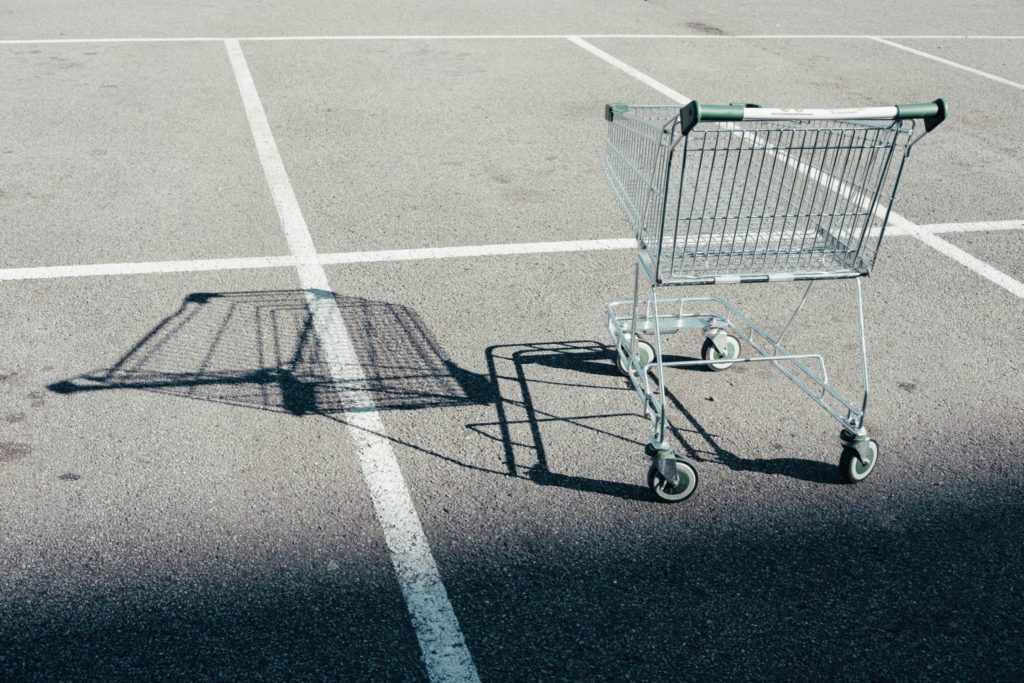
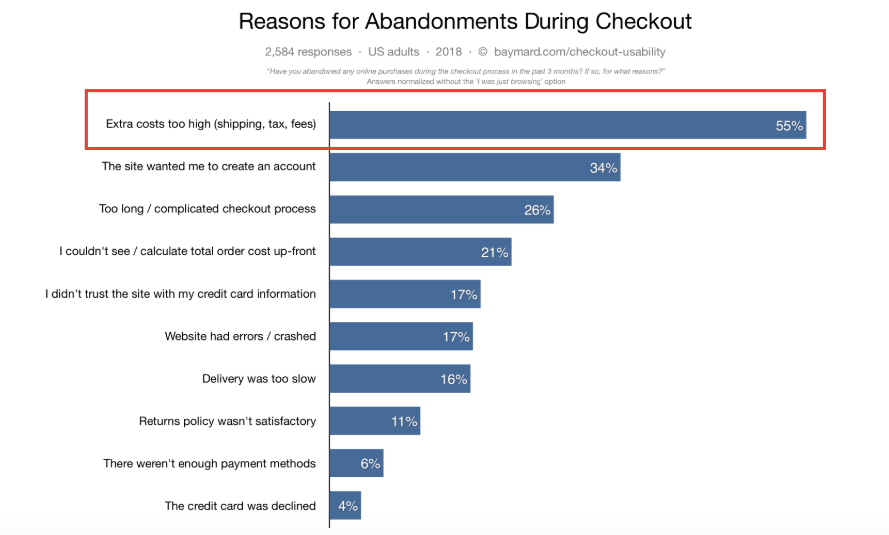


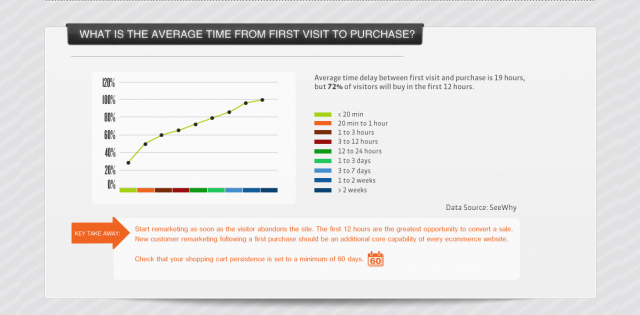
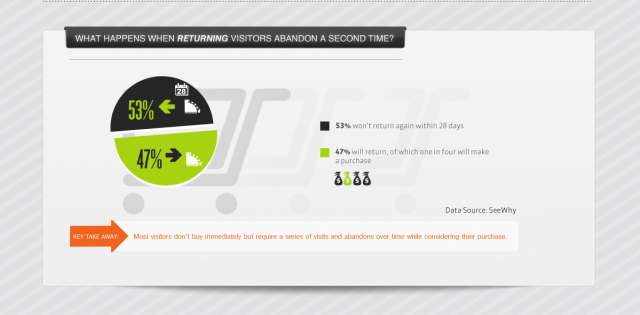
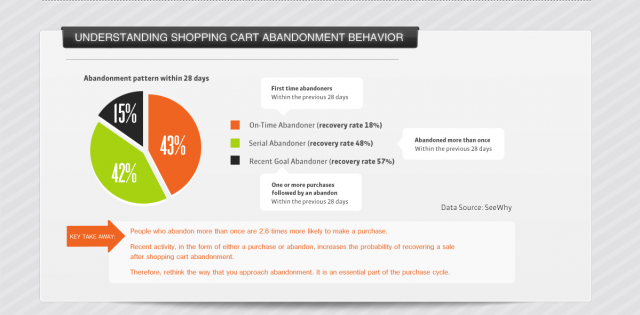


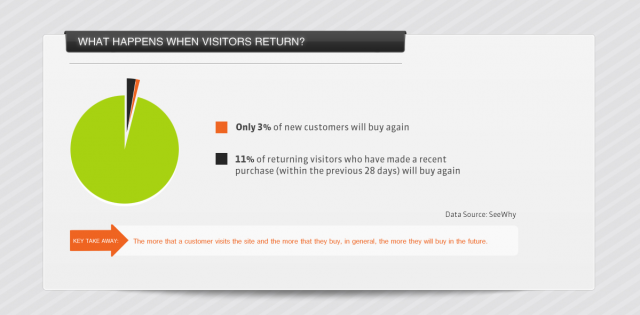

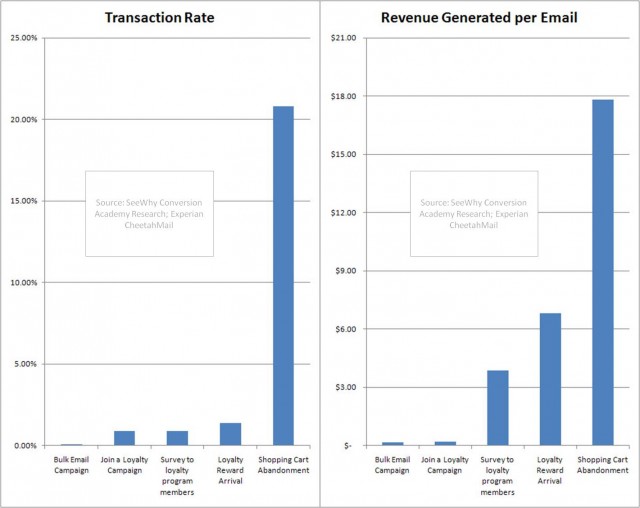
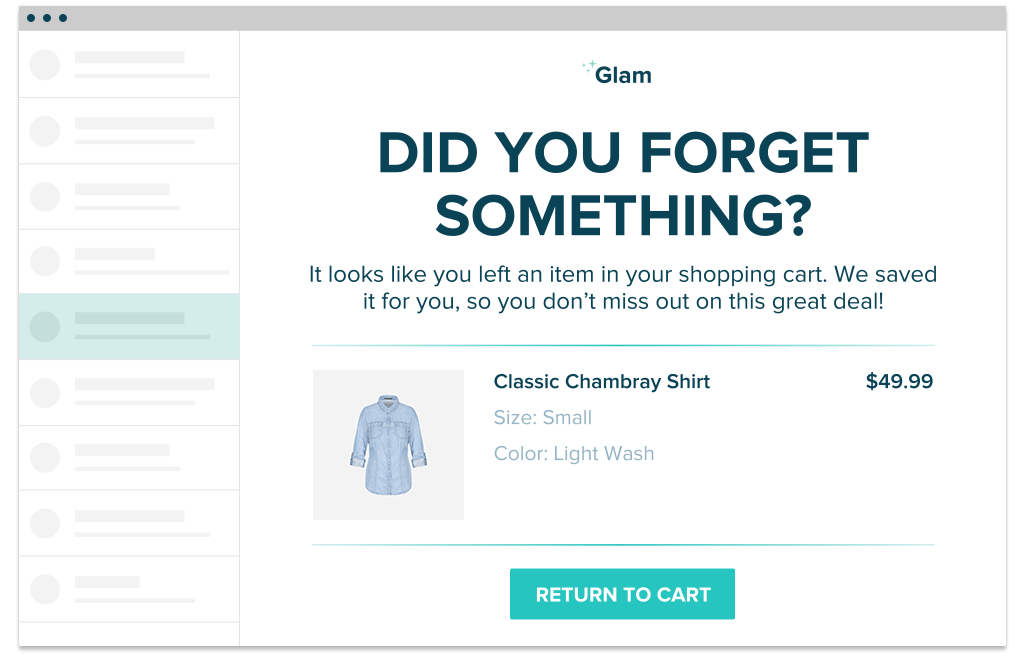






People are quite contradictory.
They don’t like the extra fees as shipping and are more likely to purchase if it is FREE which in fact is a lie as the cost is just hidden in the price.
Some things are clear to everyone:
1. Customers generally do a heavy research unless they are in a hurry so be there when it happens
2. Price/quality ratio needs to be FAIR and PROFITABLE
3. People don’t generally want to make another account somewhere or to give their e-mail too early in the process so you can send them yet another reminder e-mail they don’t want
Here’s what I would add to the list from my personal experience:
1) my preferred payment method is not accepted
2) crazy international shipping fees
3) need to create an account to purchase
Like you said, clicking the add to cart button can be part of the buying cycle, especially if the shipping/payment terms are not clear on the order page.
Oh man, those are great points too!
International shipping I imagine is tricky for companies, however, it’s something that should be made clear up front. It’s possible to display special information based on location, so I believe the merchant should say either
A.) We notice you’re outside of US/UK just to let you know up front, shipping may be a little extra, or
B.) Feel free to look around, however we don’t ship to your country, please check out http://alternativewebsite.com who offers similar goods.
I abandon my cart all the time, and for one simple reason: The silly merchant did NOT put the price anywhere on the website except within the shopping cart. I had no intention to purchase at that moment. I just needed to know the price.
Great point Derrick. If you have the price right in the item page itself you avoid all the hurdles of the buyer going through the process and not buying. For example including the shipping price within the item page plus “explaining” that if they shop for $75 worth of goods, they will get free shipping. Transparency will cut out all the surprise and lower your cart abandonment rate.
I have an issue regarding emailing people who abandon cart. How can you email them if you haven’t captured their email before they leave your site?
Is it best to go for the email address as the first thing to get from the customer so you can email them later or is best to just show them the payment details first. My gut says just capture their cc and shipping details to minimize steps but I’d love someone to explain why I’m wrong.
99% abandon on the first visit, statistically speaking, right?
So, You could optimize to capture the credit card for that 1% who are going to buy right away, and get that one sale that one time.
Or, you can optimize for membership/email so you can follow up on abandoned carts, and send follow up marketing for promotions on a regular basis.
I don’t remember the exact source at the moment, but there was a study that found 70% of consumers preferred to receive digital marketing over email.
It’s the difference between trying to get someone to buy from you one time and hoping they remember you vs. Gaining and developing a long term customer, who has a much better lifetime value. Read over the SmartPak Equestrian case study, some really great stuff in there.
Having email as the first field (default on Shopify for instance) is the way to go. My tests show that if the first fields are something people don’t need to think about (email, name), the number of people filling out the form increases. Once they get to the hard stuff (credit card number), they’ve already filled out a few fields, and now they can’t stop (people have the urge to finish what they started).
Wow, this is brilliant. I sell very little online, but was wondering last week what to do about the people who had abandoned their purchases. I had no idea I could just email them (by that, I mean, I had no idea that it would be ok to do so, and also what on earth I’d say). This has given me something to think about. Thank you very much indeed!
LivePerson, known primarily for their online chat software, had similar findings in a independent consumer study conducted earlier this year. You mention above you weren’t able to find many case studies about live chat’s influence on cart abandonment. They found that – “The need for speed is also influencing how consumers want to connect with brands. 51% stated that they were more likely to purchase from a website if they could get answers via live chat, and globally, 48% of consumers indicated that they are more likely to return to a website if live help is available. Overall, 93% of consumers consider real-time help as being beneficial during their online customer journey.” See the entire study results: http://www.liveperson.com/connected-customer/posts/ideal-online-experience-what-it-takes-consumers-click-not-abandon
Thanks for sharing that, that’s extremely useful :-)
What I was talking about specifically in that section though was using live chat, and phone sales as part of the creative in the ad retargeting campaign.
If 48% of consumers are going to be more likely to return if live help is available, and 93% consider real time help as being beneficial, why not create a display campaign that leverages retargeting technology to drive people back to their abandoned carts?
Wow!!! This article is so thorough! Thank you so much for the great research and information.
i abandon my shopping cart for the reason of more cost or if i find it not a proper quality..
FANTASTIC POST. Thanks for all the great information.
I remember seeing a website (I won’t name it to prevent any embarrasement) that had an EMPTY CART button on the checkout page.
I mean, who puts an empty cart button? What can you expect if you make it so easy for visitors to delete all the items in their cart with one click of a button?
I for one agree with the unexpected cost. It turns me off when I am presented with something like that when I think I have the amount figured out. I have to say though, if unexpected costs have an adverse effect as far as cart abandonment, then the opposite should also be the same.
For companies who have this kind of problem, surprising the customers by charging them lesser than what they really expected will surely be a game changer for you!
Letting them know of a “surprise discount” or something to that effect will surely make them feel how lucky they are for being on the right place and the right time.
Hey, Tommy, it was a real treat to read your article. Reasons that you have mentioned for the abandonment of cart , are quite true. The problem that I have experienced personally is the great deal of time, it claims. You have to create an account, give in all your personal information and then the cart will appear. Moreover, the huge shipping fees are always there.
Wow! Great article and thanks for the plug! There is so much written about cart abandonment, but you’ve pretty much nailed all the elements and discussion points into one super sized post. After doing a heap of research myself, one thing is for sure, everyone has different stats and figures for all the key points. What the real abandonment rates, when’s the best time to send the first email etc. One thing we’ve learned is that every company and vertical is totally different and everything must be tried and tested for each website accordingly.
There’s some serious research in here! Long article but well worth the read. More of our clients need to buy into engaging with cart abandoners!
Excellent and well researched article!! Kudos to you for a very comprehensive job. To nitpick, I’d say you’re missing 2 things. The first is the important role that dynamic recommendations play – both before abandonment (recs on site mean the shopper is likely to find what she’s looking for) and after (recs in retarget email make a huge difference). Full disclosure, this is what my company does. The second is the importance of easy navigation and removing barriers to purchase. Terrific article, I just signed up for the blog. Looking forward to hearing more from you. Many thanks!
How right you are Amy, and thank you for adding!
I contemplated going into detail on both of those things, however tried to keep the focus on the back end recapture vs the front end conversion.
Simple things like collapsible divs to enter promo codes, pop-up shopping carts, and in cart “one click” contextual recommendations are all things I would have loved to talk about, but it would have broken the flow of the article.
Would love to learn more about what your company does though, as that is a really awesome specialization !
Tommy, thanks for an excellent detailed post. I’ll have to re-read it again incase I have missed something. Interested to know your take on what is the impact of redirecting a customer away from a site when they click on a buy button. Do you know of any research on this area. Full disclosure. My company has just launched “buy now” button or widget that doesn’t send visitors away from your site when they purchase. It is aimed at non technical online entrepreneurs, bloggers, musicians, artists, software creators and writers who want to sell what they create and get paid by making selling via blogs and social networks simple as embedding a YouTube video. Would love to hear your thoughts on this aspect.
Thanks for the great article. Reason #2 is priceless for me. I used to think as the majority of merchants – that the majority of people who leave my website were just wasting my time.
Now, with the new perspective you gave me I will try to device a plan to convince some of the “browsers’ to buy from me.
A lot of cart abandonment happens at checkout when people see the coupon field… they then want to go searching the web for a discount and then start seeing lot’s of distractions. Why not offer one on the checkout page… the JustUno tool is a great way I have seen… where you can give them a coupon code in exchange for a tweet or FB post for some viral goodness and a win-win.
Just make it say “Our Best Coupon Offer Available Right Now…” so they don’t see a point to go in search of a better one.
I use http://www.klaviyo.com/blog/2013/02/14/klaviyo-launches-abandoned-carts-features-for-ecommerce/
For abandoned cart solutions. Iv tried vero and customer.io and klaviyo exceeds them all because they also track roi
All of them track ROI